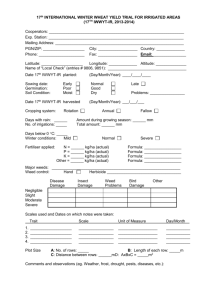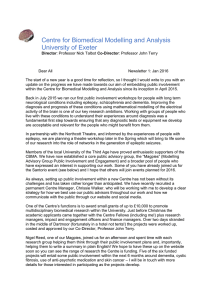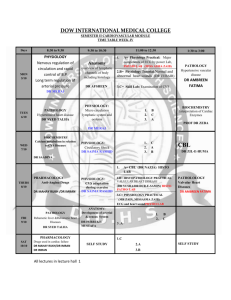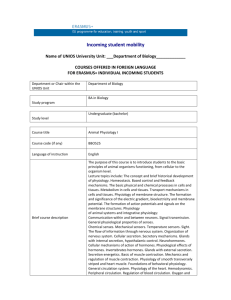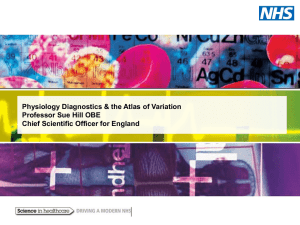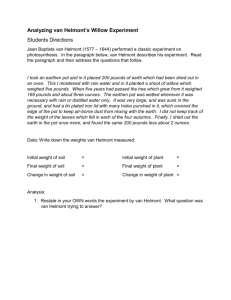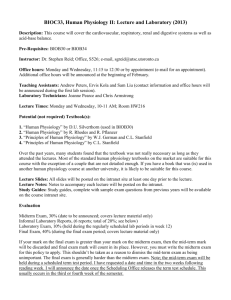History of Medicine Lecture 5
advertisement
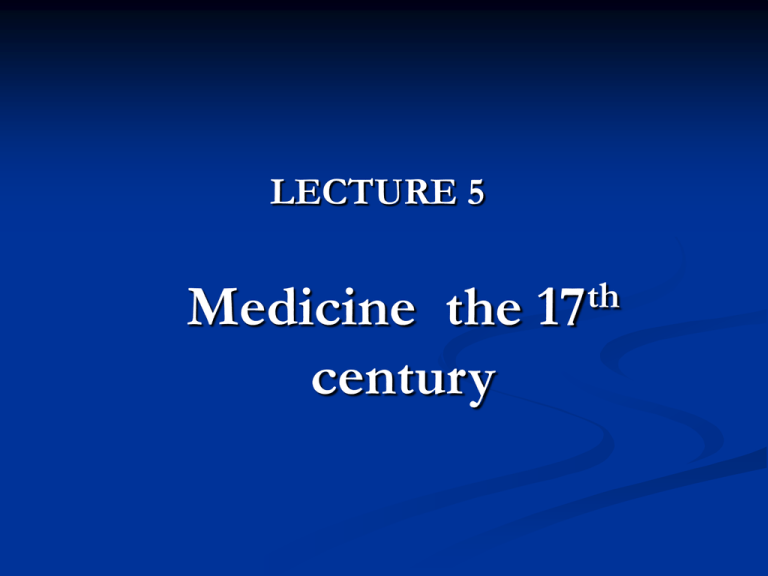
LECTURE 5 Medicine the century th 17 Main medical doctrines The development of anatomy and physiology The development of physiopathology and pathology Medicine in the 17th century The 17th century was called the Age of Scientific Revolution and represented a major turning point in the history and science. Experimentation developed and iatrochemistry – the medical chemistry – was the name given to the fusion of alchemy, medicine and chemistry. The most important figures of that time were: Jan Baptista van Helmont (1577-1644) was the leading iatrochemist. He advocated quantification and experiment and his comparison of the weight of urine with that of water was the first measurement of its specific gravity. Van Helmont was the founder of the concept of disease as a distinct entity existing parasitically in the body. This was in contradiction to the Galenic concept that disease was part of the person and represented a derangement of humours. He also considered that fever represented a reaction of the body to the imbalance of the humours. He used chemical medicines and improved on the use of mercury. Franz de la Boe, called Franciscus Sylvius (1614-1672) used the newest discoveries in chemistry. He made the laboratory an essential tool for the practice of medicine. The rise of atomism was important to the development of science and medicine Robert Boyle (1627-1691) was an important proponent of atomism. He demonstrated the necessity of air for life. He formulated the following law: the volume of a gas varies inversely with the pressure at a constant temperature. Giovanni Alfonso Barelli (1608-1679) studied the whole body starting with a simple unit, the muscle, influenced by Galileo Galilei’ s mechanical principles. Giorgio Baglivi (1669-1707) represented the extreme use of iatromechanics, likening each organ to a sprcific machine. Santorio Santorio (1561-1636) constructed thermometers and is best remembered for his research into the physiology of metabolism. William Harvey (1578-1657) proved the continuous circulation of the blood within a contained system. He gained a wide reputation and even became a court physician to King James I and to King Charles I. His greatest work was published at Frankfurt in 1628 Exercitatio Anatomica de Motu Cordis et Sanguinis in Animalibus (Anatomical Treatise on the Movement of the Heart and Blood in Animals). Harvey showed that because of the valves in the heart and the veins, blood could flow in only one direction. Seeing that both ventricles of the heart contracted and expanded together, he concluded that there was no pressure difference between them that could drive blood through the thick septum. By experiment of a live snake, he demonstrated the direction of flow toward the heart in the great vein (vena cava) and away from the heart in the main artery (aorta). In the days of Hippocrates, the importance of body temperature was well recognized, but the physician had only his hand to evaluate it. In 1592 Galileo constructed a thermometer with no scale of measurement and was influenced by atmospheric pressure. The first wide use of thermometry in clinical practice was by Hernann Boerhaave (1668 – 1738) in Holland and his students in Vienna. One of the most important inventions in the development of medicine and general science was the microscope. Malpighi was regarded as the founder of biological microscopy. By developing techniques for preparing tissues to be examined under the microscope he was able to make observations otherwise impossible. Many other advances were made in understanding the anatomy and physiology of the body: Francis Glisson (1597-1677) described in detail the liver, the stomach and the intestines Thomas Wharton (1614-1673) described the characteristics of the digestive, lymphatic and sexual glands Robert Hooke (1635-1703) demonstrated that even without chest movement an animal could survive as long as air is pumped into the lungs Richard Lower (1631-1691) was the first to transfuse blood directly Thomas Willis (1621-1675) published De Anatome Celebri what was a summary of the nervous system. Thomas Sydenham (1624-1689) was the century’s most famous clinical leader considered that each patient was a unique dynamic entity in whom a disease could vary from person to person. CONCLUSIONS Scientific progress in the 17th century came less from the universities than from new public and private scientific societies: The Academy of the Lynx (Rome), Academie des Science (France) and The Royal Society (England) were the most famous. A new medication appeared: cinchona, as a treatment for malaria In surgery the major operations were: suture of holes in the intestines, removal of tumors and even plastic operations on the lip and nose The attitude towards mental illness continued to be ambivalent Epidemics of plague, smallpox, scarlet fever, chicken pox were common John Graunt (1620-1674) was the first person to use medical statistics that had impostant influences Hospitals began to be used for medical research and teaching.
